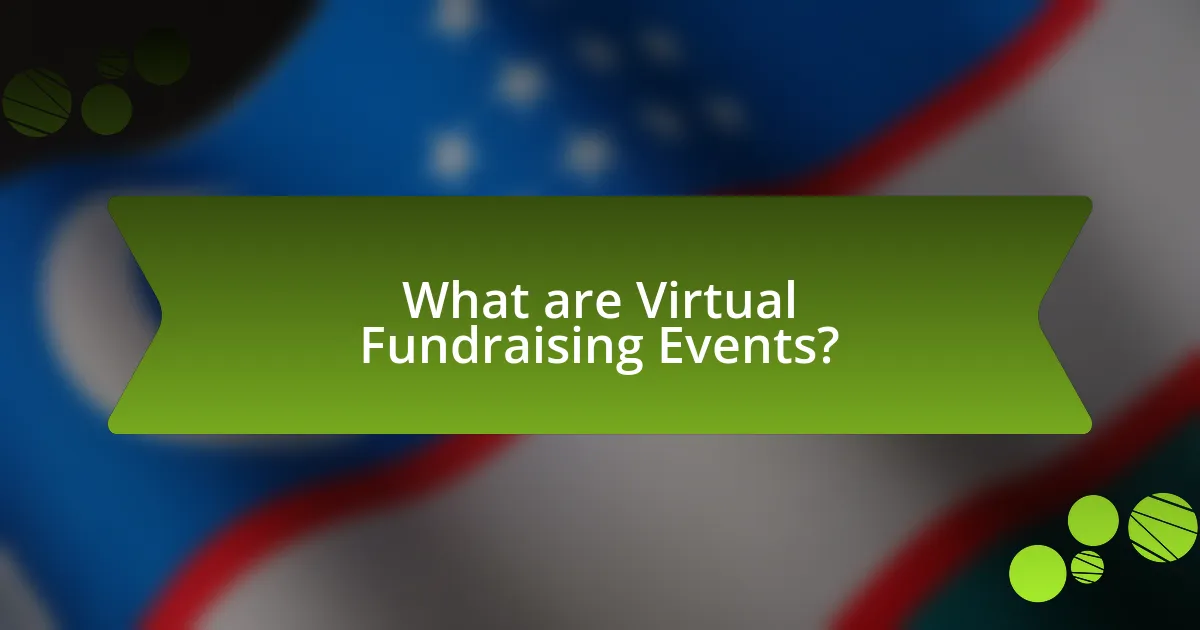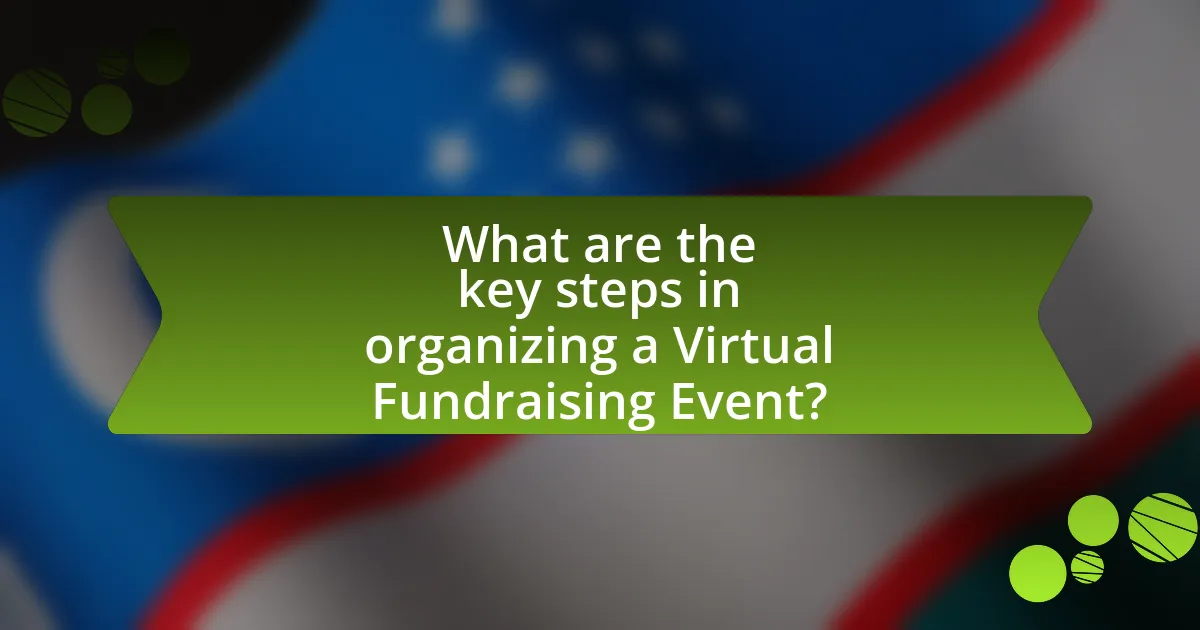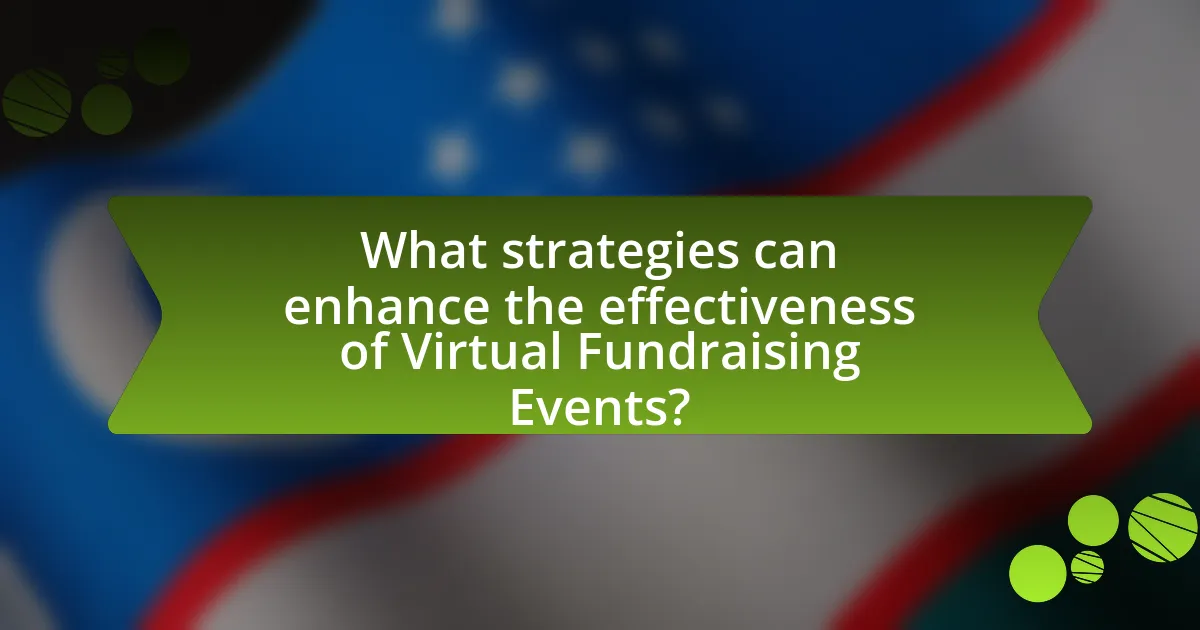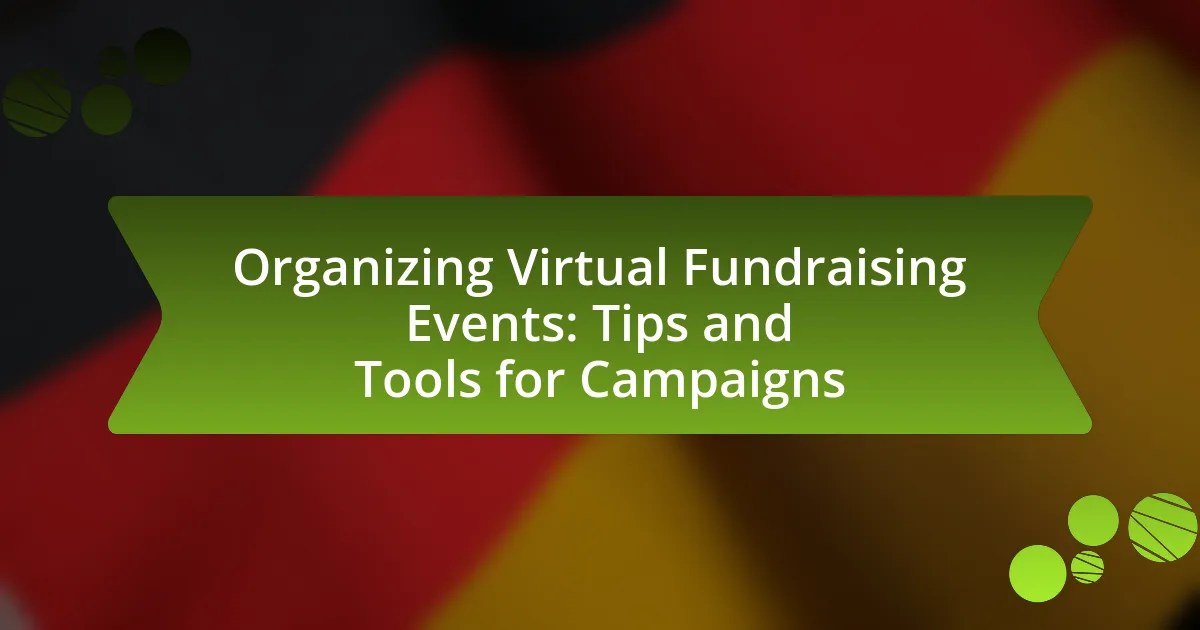Virtual fundraising events are online gatherings aimed at raising money for various causes and organizations, utilizing digital platforms to engage participants through activities like auctions and live streams. This article outlines the differences between virtual and traditional fundraising, emphasizing the advantages of broader reach and enhanced donor engagement through technology. Key strategies for organizing successful virtual events include setting clear goals, leveraging essential tools, and employing effective audience engagement techniques. Additionally, the article addresses common challenges faced in virtual fundraising and offers best practices to maximize outcomes and maintain donor relationships post-event.

What are Virtual Fundraising Events?
Virtual fundraising events are online gatherings designed to raise money for a cause or organization. These events leverage digital platforms to engage participants, allowing them to contribute financially while participating in activities such as auctions, live streams, or social campaigns. The rise of virtual fundraising has been accelerated by the COVID-19 pandemic, with a report from the Fundraising Effectiveness Project indicating that online giving increased by 21% in 2020 compared to the previous year. This shift demonstrates the effectiveness of virtual events in reaching wider audiences and generating donations.
How do Virtual Fundraising Events differ from Traditional Fundraising?
Virtual fundraising events differ from traditional fundraising primarily in their format and accessibility. Virtual events utilize online platforms to engage participants, allowing for broader geographic reach and participation without physical constraints, while traditional fundraising typically involves in-person gatherings that limit attendance to local supporters. For instance, a study by Nonprofit Source in 2021 indicated that virtual events can increase donor engagement by 30% due to the convenience of online participation. Additionally, virtual events often leverage technology for real-time interaction and data collection, enhancing the overall fundraising experience compared to the more static nature of traditional events.
What technologies are essential for hosting Virtual Fundraising Events?
Essential technologies for hosting virtual fundraising events include video conferencing platforms, online payment processing systems, and event management software. Video conferencing platforms like Zoom or Microsoft Teams facilitate real-time interaction and engagement among participants, which is crucial for maintaining interest and connection during the event. Online payment processing systems, such as PayPal or Stripe, enable secure and efficient transactions, allowing attendees to donate easily. Event management software, like Eventbrite or Hopin, helps organizers manage registrations, ticketing, and attendee communication, streamlining the overall event experience. These technologies collectively enhance the effectiveness and reach of virtual fundraising efforts.
How do audience engagement strategies vary between virtual and in-person events?
Audience engagement strategies differ significantly between virtual and in-person events due to the nature of interaction and accessibility. In-person events typically rely on face-to-face communication, allowing for immediate feedback and personal connections, which can enhance engagement through networking opportunities and physical activities. Conversely, virtual events utilize digital tools such as live chats, polls, and interactive platforms to foster engagement, often requiring more structured content to maintain attention over screens. For instance, a study by the Event Marketing Institute found that 70% of attendees at in-person events felt more engaged compared to 50% at virtual events, highlighting the impact of physical presence on audience involvement.
Why are Virtual Fundraising Events important for organizations?
Virtual fundraising events are important for organizations because they expand reach and accessibility, allowing participation from a global audience. These events eliminate geographical barriers, enabling organizations to engage supporters who may not be able to attend in-person events. According to a report by Nonprofit Source, online fundraising grew by 21% in 2020, highlighting the effectiveness of virtual platforms in generating donations. Additionally, virtual events often have lower overhead costs compared to traditional events, maximizing the funds raised for the organization’s mission.
What advantages do Virtual Fundraising Events offer in terms of reach?
Virtual fundraising events significantly enhance reach by allowing organizations to connect with a global audience. Unlike traditional in-person events, which are limited by geographical constraints, virtual events can attract participants from various locations, increasing potential donor engagement. For instance, a study by Nonprofit Tech for Good found that virtual events can increase attendance by up to 50% compared to physical events, demonstrating the expansive reach that online platforms provide. This broader access not only diversifies the donor base but also amplifies fundraising potential, as organizations can engage with individuals who may not have been able to attend in person due to distance or other barriers.
How can Virtual Fundraising Events enhance donor relationships?
Virtual fundraising events enhance donor relationships by providing interactive and engaging platforms for communication and connection. These events allow organizations to showcase their mission and impact in real-time, fostering a sense of community among donors. For instance, studies show that 70% of donors feel more connected to organizations that offer virtual engagement opportunities, such as live Q&A sessions and behind-the-scenes content. This direct interaction not only builds trust but also encourages ongoing support, as donors are more likely to contribute when they feel personally involved and informed about the cause.

What are the key steps in organizing a Virtual Fundraising Event?
The key steps in organizing a Virtual Fundraising Event include defining the event’s purpose, selecting a suitable platform, promoting the event, engaging participants during the event, and following up afterward. Defining the event’s purpose ensures clarity on fundraising goals, while selecting a platform like Zoom or Facebook Live facilitates effective communication. Promotion through social media and email campaigns increases visibility and attendance. Engaging participants with interactive elements, such as live Q&A sessions or auctions, enhances the experience. Finally, following up with thank-you messages and updates on the impact of donations fosters ongoing relationships with supporters.
How do you set clear goals for your Virtual Fundraising Campaign?
To set clear goals for your Virtual Fundraising Campaign, define specific, measurable objectives that align with your overall mission. For example, aim to raise a specific dollar amount, such as $10,000, within a defined timeframe, like one month. This approach allows for tracking progress and adjusting strategies as needed. Research indicates that campaigns with clear goals are 30% more likely to meet or exceed their fundraising targets, highlighting the importance of goal clarity in driving success.
What metrics should you consider when defining success?
When defining success in virtual fundraising events, key metrics to consider include total funds raised, donor engagement rates, participant attendance, and conversion rates. Total funds raised directly indicates the financial success of the campaign, while donor engagement rates reflect how effectively the event connected with supporters, often measured through interactions such as comments, shares, and follow-up donations. Participant attendance provides insight into the event’s reach and appeal, and conversion rates show the percentage of attendees who made a donation, highlighting the effectiveness of the event in motivating contributions. These metrics collectively offer a comprehensive view of the event’s success and areas for improvement.
How can you align your goals with your organization’s mission?
To align your goals with your organization’s mission, first, clearly understand the organization’s mission statement and core values. This understanding allows you to identify how your personal or team goals can support and enhance the mission. For example, if the organization’s mission focuses on community engagement, setting a goal to increase participation in virtual fundraising events directly supports that mission. Research shows that organizations with aligned goals and missions experience higher employee satisfaction and engagement, which can lead to more successful fundraising outcomes.
What tools are available for planning and executing Virtual Fundraising Events?
Tools available for planning and executing Virtual Fundraising Events include platforms like Zoom, Eventbrite, and GoFundMe. Zoom facilitates live video interactions, allowing for virtual gatherings and presentations. Eventbrite offers event management features, including ticket sales and registration tracking, which are essential for organizing fundraising events. GoFundMe provides a crowdfunding platform specifically designed for raising funds online, enabling easy donation collection. These tools are widely used in the nonprofit sector, with Eventbrite reporting over 4 million events hosted in 2019, demonstrating their effectiveness in event organization and fundraising.
Which platforms are best for hosting Virtual Fundraising Events?
The best platforms for hosting virtual fundraising events include Zoom, Facebook Live, and YouTube Live. Zoom offers features like breakout rooms and screen sharing, making it suitable for interactive events. Facebook Live allows for easy engagement with a large audience and integrates well with social media sharing. YouTube Live provides a robust streaming service with high-quality video and the ability to reach a global audience. These platforms are widely used due to their user-friendly interfaces and extensive features that enhance virtual fundraising efforts.
How can social media be leveraged to promote your event?
Social media can be leveraged to promote your event by creating targeted campaigns that engage your audience and encourage sharing. Utilizing platforms like Facebook, Instagram, and Twitter allows for the dissemination of event details, visuals, and updates, reaching a broader audience. According to a study by Eventbrite, 95% of event creators use social media to promote their events, highlighting its effectiveness in increasing visibility and attendance. Engaging content, such as countdowns, behind-the-scenes footage, and interactive posts, can further enhance audience interest and participation.

What strategies can enhance the effectiveness of Virtual Fundraising Events?
To enhance the effectiveness of Virtual Fundraising Events, organizations should implement targeted marketing strategies, engage participants through interactive content, and utilize data analytics for optimization. Targeted marketing strategies, such as personalized email campaigns and social media promotions, can increase attendance and donations by reaching specific demographics. Engaging participants through interactive content, like live polls, Q&A sessions, and gamification, fosters a sense of community and encourages active participation, which can lead to higher donation rates. Utilizing data analytics allows organizations to track engagement metrics and donor behavior, enabling them to refine their approach for future events. For instance, a study by Nonprofit Hub found that events with interactive elements saw a 30% increase in donations compared to traditional formats.
How can storytelling be used to engage donors during the event?
Storytelling can engage donors during an event by creating emotional connections that resonate with their values and motivations. When organizations share compelling narratives about the impact of their work, such as personal stories of beneficiaries or transformative projects, they foster empathy and a sense of urgency among potential donors. Research indicates that emotional storytelling can increase donations by up to 30%, as it helps donors visualize the difference their contributions can make. By incorporating relatable characters, vivid imagery, and clear outcomes, organizations can effectively capture attention and inspire action, ultimately enhancing donor engagement during the event.
What are the best practices for crafting compelling narratives?
The best practices for crafting compelling narratives in the context of virtual fundraising events include focusing on emotional engagement, clarity of message, and a strong call to action. Emotional engagement captures the audience’s attention and fosters a connection, which is crucial for motivating donations. Clarity of message ensures that the audience understands the purpose of the fundraising campaign and the impact of their contributions. A strong call to action directs the audience on how to support the cause effectively. Research indicates that narratives that evoke emotions can increase donation likelihood by up to 50%, demonstrating the importance of these practices in successful fundraising campaigns.
How can testimonials and case studies be integrated into your event?
Testimonials and case studies can be integrated into your event by showcasing them during presentations and incorporating them into promotional materials. Presenters can highlight specific success stories from past campaigns, using testimonials to build credibility and engage the audience. For instance, displaying video testimonials from previous donors or beneficiaries can create an emotional connection, while case studies can provide concrete examples of how funds were utilized effectively. Research indicates that 79% of consumers trust online reviews as much as personal recommendations, underscoring the importance of including authentic testimonials in your event strategy.
What role does follow-up play after a Virtual Fundraising Event?
Follow-up plays a critical role after a Virtual Fundraising Event by reinforcing donor relationships and maximizing contributions. Effective follow-up communication can increase donor retention rates, as studies show that organizations that engage with donors post-event see a 30% higher likelihood of repeat donations. This engagement can include personalized thank-you messages, updates on the impact of their contributions, and invitations to future events, which collectively foster a sense of community and commitment among supporters.
How can you effectively thank donors and participants post-event?
To effectively thank donors and participants post-event, send personalized thank-you messages that acknowledge their specific contributions and involvement. Personalization enhances the emotional connection and shows genuine appreciation, which can lead to increased loyalty and future support. According to a study by the Association of Fundraising Professionals, personalized communication can increase donor retention rates significantly, demonstrating the importance of tailored acknowledgments in fostering long-term relationships.
What strategies can be used to maintain engagement with donors after the event?
To maintain engagement with donors after the event, organizations can implement follow-up communication strategies, personalized thank-you messages, and ongoing updates about the impact of their contributions. Follow-up communication, such as emails or phone calls, reinforces the relationship and shows appreciation, which is crucial as studies indicate that personalized outreach increases donor retention rates by up to 30%. Personalized thank-you messages can include specific details about how the donor’s contribution is making a difference, fostering a sense of connection and accountability. Additionally, providing ongoing updates about the organization’s activities and the outcomes of the fundraising efforts keeps donors informed and engaged, as research shows that transparency and communication significantly enhance donor loyalty.
What are some common challenges in organizing Virtual Fundraising Events?
Common challenges in organizing virtual fundraising events include technical issues, participant engagement, and fundraising goals. Technical issues often arise from unreliable internet connections or platform malfunctions, which can disrupt the event flow and frustrate attendees. Participant engagement is another significant challenge, as virtual formats can lead to distractions and reduced interaction compared to in-person events. Additionally, meeting fundraising goals can be difficult due to competition with other online events and the lack of physical presence that typically encourages donations. According to a report by Nonprofit Source, 45% of nonprofits cite technology as a barrier to successful virtual fundraising, highlighting the importance of addressing these challenges effectively.
How can technical issues be mitigated during the event?
Technical issues can be mitigated during the event by implementing a robust technical support system. This includes having dedicated IT personnel available to address any problems in real-time, ensuring that all equipment is tested prior to the event, and utilizing reliable software platforms known for their stability. Research indicates that 70% of technical failures can be avoided with proper pre-event testing and contingency planning, highlighting the importance of preparation in minimizing disruptions.
What strategies can help overcome donor fatigue in virtual settings?
To overcome donor fatigue in virtual settings, organizations should implement personalized communication strategies. Tailoring messages to individual donors based on their previous interactions and preferences can significantly enhance engagement. Research indicates that personalized outreach increases donor retention rates by up to 50%, as it fosters a sense of connection and appreciation. Additionally, varying the format of virtual events—such as incorporating interactive elements like polls, Q&A sessions, and breakout discussions—can maintain donor interest and participation. Studies show that interactive virtual events can boost engagement levels by 70% compared to traditional formats. Lastly, setting clear, achievable goals for fundraising campaigns and regularly updating donors on progress can create a sense of involvement and urgency, further mitigating fatigue.
What are the best practices for successful Virtual Fundraising Events?
The best practices for successful Virtual Fundraising Events include clear goal setting, engaging content, effective promotion, and utilizing technology efficiently. Clear goal setting ensures that the event has a defined purpose, such as raising a specific amount of money or increasing donor engagement. Engaging content, such as compelling storytelling and interactive elements, keeps participants interested and encourages donations. Effective promotion through social media, email campaigns, and partnerships increases visibility and attendance. Utilizing technology, such as reliable streaming platforms and user-friendly donation tools, enhances the overall experience and facilitates contributions. According to a report by Nonprofit Source, organizations that effectively engage their audience can increase donations by up to 30%.
How can you ensure a seamless experience for attendees?
To ensure a seamless experience for attendees, implement a robust technology platform that supports high-quality audio and video streaming. This is crucial because technical issues can disrupt engagement; for instance, a study by the Event Marketing Institute found that 70% of attendees cite technical difficulties as a primary reason for dissatisfaction in virtual events. Additionally, provide clear communication before, during, and after the event, including detailed instructions on how to access the platform and participate in activities. This proactive approach minimizes confusion and enhances attendee satisfaction.
What tips can help maximize fundraising outcomes during the event?
To maximize fundraising outcomes during the event, engage attendees through interactive elements such as live polls, Q&A sessions, and real-time donation tracking. These strategies foster a sense of community and urgency, encouraging participants to contribute. Research indicates that events incorporating interactive features can increase engagement by up to 70%, leading to higher donation rates. Additionally, showcasing specific funding goals and progress during the event can motivate attendees to give more, as they see the direct impact of their contributions.



